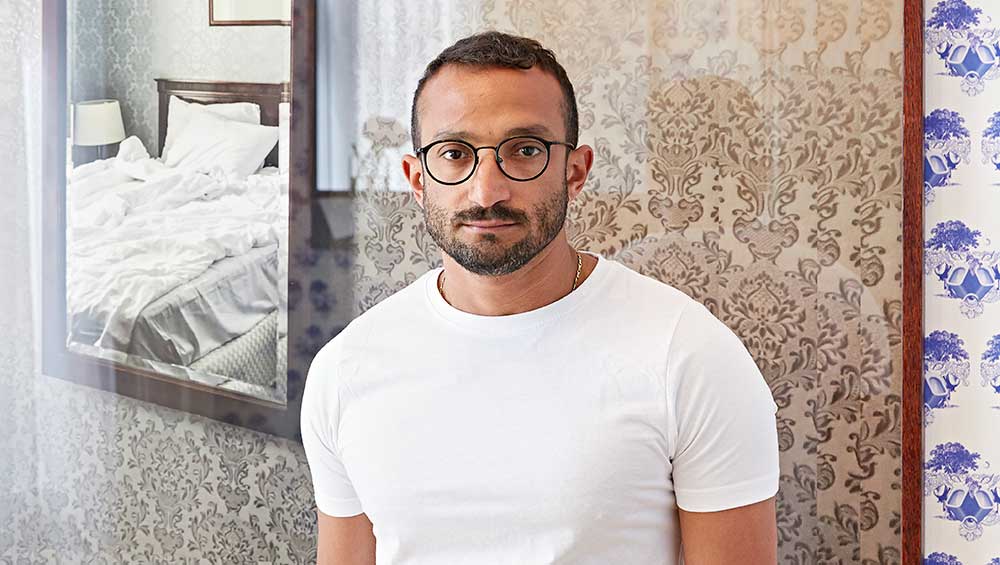
Mahmoud Khaled, 2022. Photo: Andy Stagg.
by JOE LLOYD
Who lives in a house like this? The grand salon of The Mosaic Rooms, a majestic townhouse in west London, has been shrouded in luscious red curtains. Two painted panels show a distressed man, head in hands. And in the centre of a room is a long, slim daybed with black upholstery that has a touch of S&M. In the next room, things get even more disquieting: an endlessly rotating circular bed, akin to that favoured by the Playboy founder Hugh Hefner.
This is Fantasies on a Found Phone, Dedicated to the Man Who Lost it, a new exhibition by the Berlin-based artist Mahmoud Khaled. It was inspired by a series of etchings by the German symbolist Max Klinger, and recreates the home of an anxiety-racked individual. In the bedroom, a sound work burlesques the sort of calming ASMR (autonomous sensory meridian response) apps people now use to help them go to sleep, a discordant, insomnia-inducing soundtrack.
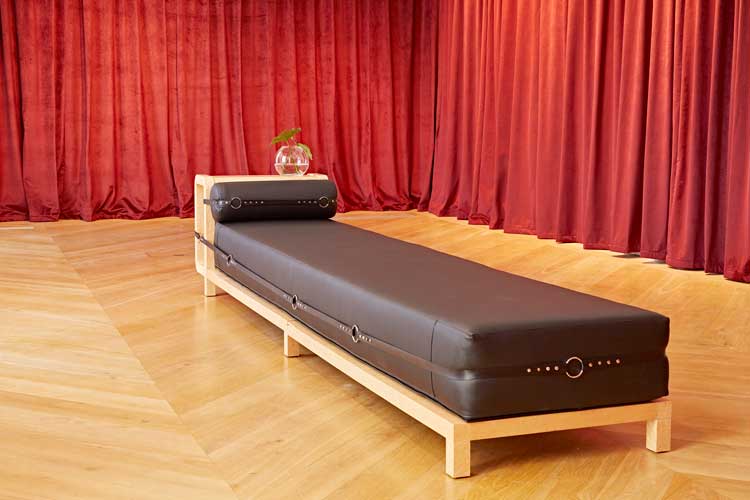
Mahmoud Khaled, Fantasies on a Found Phone, Dedicated to the Man Who Lost it, 2022, multimedia installation. Courtesy of the artist. Installation view at The Mosaic Rooms. Photo: Andy Stagg.
Khaled’s work explores gender, politics and desire, particularly of the same-sex variety. He was born in 1982, in Alexandria, where he studied traditional painting. His practice is multimedia, taking in video, sound, photography and text works. Recent pieces are presented as entire rooms or dwellings: the exhibition as an artistic medium. His Proposal for a House Museum of an Unknown Crying Man (2017), first shown at the Istanbul Biennial, imagined the preserved home of a member of the Cairo 52, a group of men who were arrested, beaten and imprisoned after a police raid on a gay nightclub. Khaled imagined a time when one of these figures had been redeemed and vindicated, and their private dwelling turned into a monument.
A section of this work has been loaned to Metroland Studios for the Brent Biennial in north-west London. Ahead of the Biennial’s opening, Studio International spoke to Khaled about the wonder of house museums, the artist as activist and the cultural trip of Hugh Hefner.
Joe Lloyd: You studied painting, but you create these very multimedia artworks. How did you transition?
Mahmoud Khaled: The education I received in Alexandria was very specific. It was very academic, old-school painting. It wasn’t easy, but it shaped me quite a lot – in how I think about the production of the image, and the capacity of the artist to produce an image from scratch, literally. Later on, after graduation, I produced a lot of works that were basically a reaction to this education. I wanted to unlearn what I had learned. I love painting so much, but this specific education made me feel that painting is very limited for the kind of issues that I would like to talk about in my work. Gradually, after this kind of reactionary work towards this specific education, I tried to find my own language. I think I find it very liberating that I don’t relate to – or I don’t present my work in – a specific medium. I can work on anything based on the ideas and research that I’m working on.
JL: Can you describe some of these early, reactionary works?
MK: I did a piece that’s interesting, when I think about it in retrospect, to the shows we have in London right now. Called Two Single Rooms, it was a giant exhibition between me and a Swiss artist who was in residence in Cairo at the time. It was in 2004. We booked two single hotel rooms in Cairo, and we made our exhibitions. It was mainly about how we felt as individuals in a big city like Cairo that has a lot of social codes and a very strict system. And how this single room in a hotel could be an incubator for this individuality that you can perform yourself. So, when I think about this piece in relation to what I’m doing right now, I see a kind of connection.
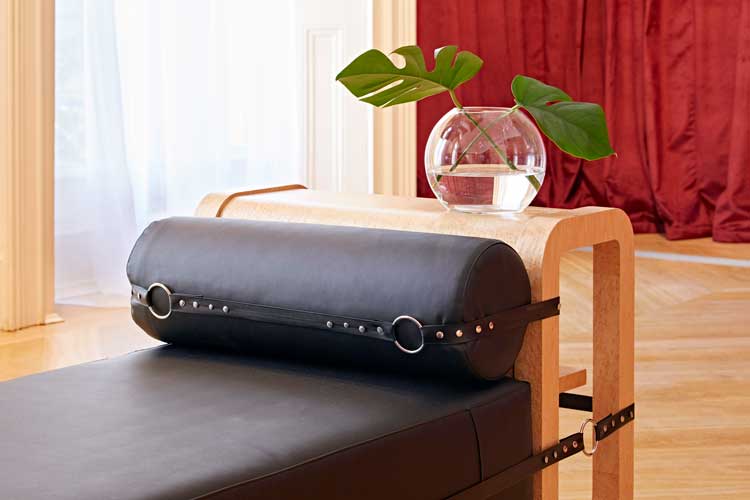
Mahmoud Khaled, Fantasies on a Found Phone, Dedicated to the Man Who Lost it, 2022, multimedia installation. Courtesy of the artist. Installation view at The Mosaic Rooms. Photo: Andy Stagg.
JL: Your two works in London are large-scale, presenting simulated dwellings. What drove you to this format?
MK: It gives me a chance to design the entire experience of the audience. It’s not just an exhibition where you see pictures framed on the wall, but it’s an experience that I like to design from the beginning to the end – even when you go to the bathroom, the in-between spaces, the curtains, the signage, captions, everything. It wasn’t like a conscious decision, but gradually I realised that I enjoy designing and having full control in this experience. Also, the end result always becomes like an artwork. So, the exhibition itself became a medium. The exhibition becomes an artwork.
JL: Your work in the Brent Biennial is an excerpt from a sort of fictional house museum.
MK: In Brent, we’re presenting the bedroom and the study, and a little entrance space, but also a video work documenting the entire museum collection. The work is a proposal for a House Museum of an Unknown Crying Man – this is the title of it. And it’s a museum that does not exist. I like so much to confirm the existence of the imagination of this institution in our lives, although it doesn’t exist.
The work is on loan from the Unknown Crying Man Museum. This is something very important for me: that the museum exists and is loaning its own collection to other shows. We decided to focus on the most intimate parts of the house.
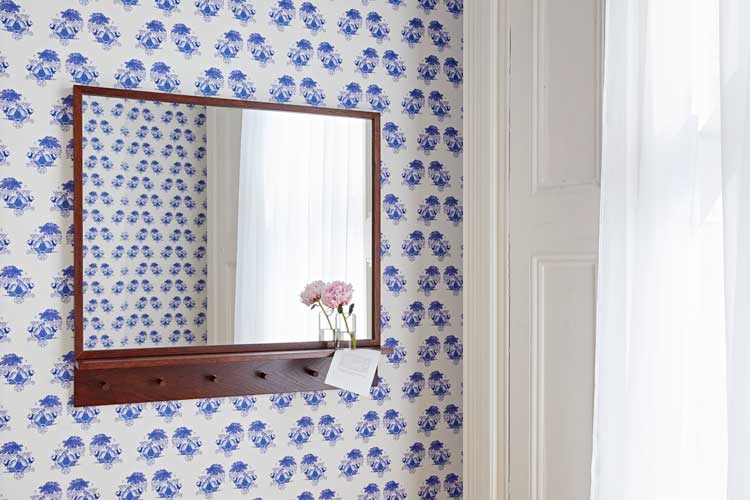
Mahmoud Khaled, Fantasies on a Found Phone, Dedicated to the Man Who Lost it, 2022, multimedia installation. Courtesy of the artist. Installation view at The Mosaic Rooms. Photo: Andy Stagg.
JL: The experience of walking into a room that has the hallmarks of someone's personal life is quite a striking experience. Why do you work with such intimate spaces?
MK: Intimacy is a paradoxical state of existence. I’m especially interested in problematised intimacy, intimacy that is politicised in a way and brings political discussion around it.
I’m also interested in the format of the house museum as a medium. I enjoy visiting house museums in every city I go to. Part of the experience is this strong sense of absence and delay. When you visit the house, you’re always late. If you’re on time, it’s not working. The owner of the house has died, or been sent to exile, or otherwise left. And this is the moment when you visit. That experience is very interesting for me, and I like to somehow recreate it in my shows.
I’m also interested in the idea of a normal house becoming transformed into the form of an exhibition. And it all happens because of a very, very strong curatorial voice. We have the curatorial text that tells you that the person used to sleep on this couch, or cry on this bed, or died here. This helps you generate the images, or the legacy of the person you’re looking for in the house.
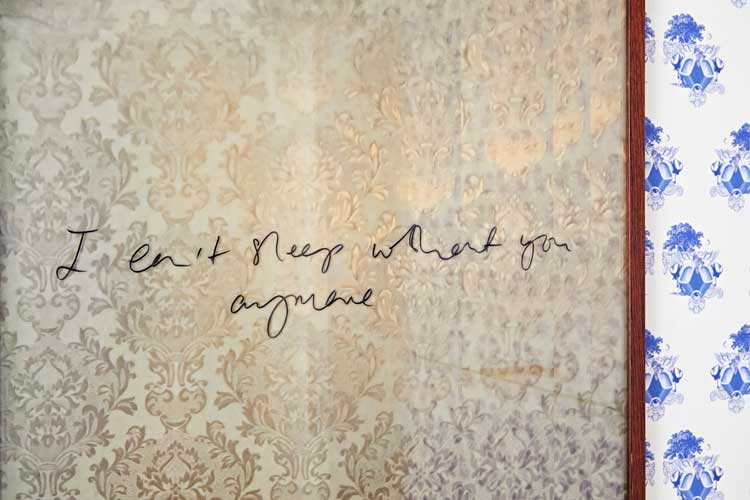
Mahmoud Khaled, Fantasies on a Found Phone, Dedicated to the Man Who Lost it, 2022, multimedia installation. Courtesy of the artist. Installation view at The Mosaic Rooms. Photo: Andy Stagg.
JL: You cannot tell from walking through the rooms, but the memorial was inspired by an incident of institutional homophobia in Cairo. Do you feel art has political potential?
MK: I don’t think too much about the political effect, but I understand that it’s politically charged. It’s coming from a political moment, a political place. But I don’t honestly expect too much. And I am happy that I don’t expect too much. There is lots of writing about artist-activists. I know very well that I’m an artist, but I’m not sure about the activism. There is an activist right now who is on a 90-day hunger strike in an Egyptian prison, who is actually a UK citizen. I cannot compare myself with situations like that.
But I like to play the role of a person who is proposing, imagining and staging things more than trying to confront things, and to release statements towards what’s happening and react.
JL: One could say you are providing spaces where people can form their own thoughts.
MK: Exactly. And I think the proposal for the House Museum of an Unknown Crying Man, was a good learning example for this, because it’s basically a memorial for imagining a moment when, maybe 30, 40 years from now, someone will decide to say sorry about what happened, and transform one of the houses into a memorial for the one of victims. This is just an imagination for a moment that hopefully will come later.
JL: The work in the Mosaic Rooms, on the other hand, is inspired less by an event than by a state of mind. How did it come about?
MK: I had a strong desire to move on from the Unknown Crying Man. That work was based on a very specific sociopolitical moment in Egypt and is very specific in time and place. With the Mosaic Room show, I intentionally wanted to remove time and place from it completely. I wanted to abstract the location and the time.
The work, the title of the exhibition, is Fantasies on a Found Phone, Dedicated to the Man Who Lost It. The entire show is inspired by a beautiful piece by the German painter Max Klinger. He has a work called Paraphrase on the Finding of a Glove. Klinger found a very elegant feminine glove on a skating rink in Berlin, dropped by a lady who was skating. He tried to follow her to give it back, but she had left already. He kept the glove and kept fantasising about the lady based on the glove. The glove became the object of desire. It occupied his dreams, created insomnia, longing and desire, troubled him for several nights. And he produced a beautiful series of ink etchings that celebrate this period of anxiety, longing and desire. I was so moved when I saw it.
The main question for me was, what if Klinger was living with us right now, and he found an iPhone instead of a glove? What would the artwork be? And that’s how I started building the show. The whole exhibition is trying to paint a portrait of an owner of a mobile phone whom we don’t know. This portrait is based on the found images and apps we found on the phone. And it is painted by creating a domestic environment that could possibly be owned by this protagonist.
JL: And it’s in the Mosaic Rooms, itself a domestic interior.
MK: The space is beautiful. It’s a Victorian house. It could also be a house museum, but it’s not. I didn’t want to pretend that the show is trying to stage a house museum, but it’s using the house museum as a medium, as a form. The exhibition space has a very strong architectural identity that I had to be in dialogue with. But I also used the logic of a house museum in terms of designing an experience for the audience.
The first room is a landing room or the entrance hall, which is the room where normally we find all the information about this house museum. It’s almost acting like a reception, a gift shop and a cloakroom. And then you see two domestic interiors, two sleep environments, let’s say. The first one is the grand room, which used to be the grand salon. I saw archive images of how the house used to be. It was full of antiques, very spectacular. There was a lot of the display of the wealth of the resident, the glamour of his life. I wanted to create this kind of feeling, but with a few gestures, basically.
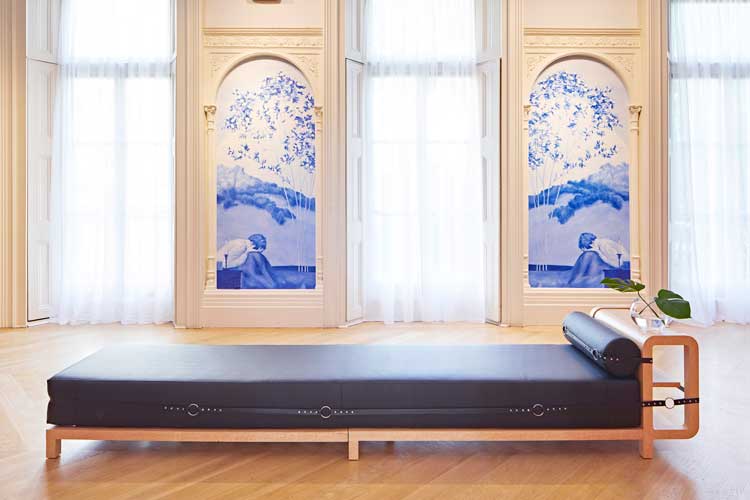
Mahmoud Khaled, Fantasies on a Found Phone, Dedicated to the Man Who Lost it, 2022, multimedia installation. Courtesy of the artist. Installation view at The Mosaic Rooms. Photo: Andy Stagg.
So, we have a long daybed, which is referencing museum benches and exhibition furniture, but maybe with a little bit of kink. And two trompe l’oeil paintings on the arches, inspired by Klinger. Also, trompe l’oeil painting is a very traditional form of decoration in wealthy houses. But normally it’s to create something very beautiful, very epic. But here the paintings are celebrating a state of anxiety. Then there’s a soundtrack, inspired by the podcasts that we hear on sleeping apps. And the second room is a bedroom. Somehow, it’s a memorial dedicated to the people who cannot speak.
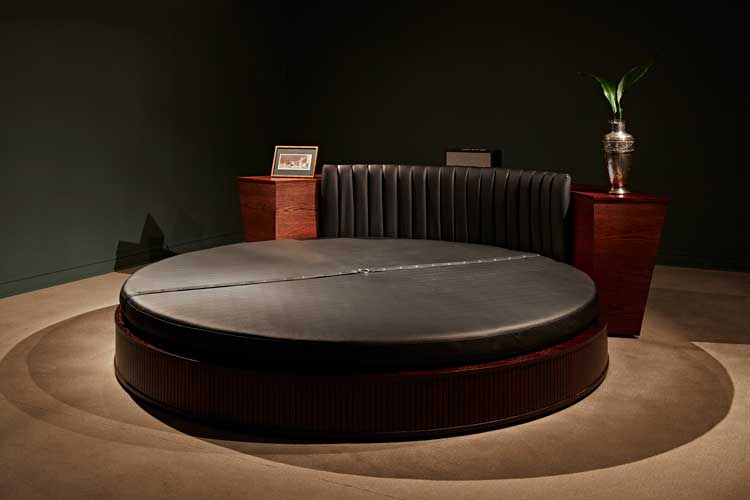
Mahmoud Khaled, Fantasies on a Found Phone, Dedicated to the Man Who Lost it, 2022, multimedia installation. Courtesy of the artist. Installation view at The Mosaic Rooms. Photo: Andy Stagg.
The daybed is a very interesting piece of furniture for me. First of all, it has a lot of connotations with psychoanalysis. It’s a piece of furniture that invites you to be very comfortable, but also to speak about very uncomfortable things. It’s a place where you’re not supposed to sleep entirely, but you doze off between sleeping and daydreaming. It’s a very paradoxical piece of furniture. In this particular installation, I wanted to present it as a stage for an unexpected performance that might happen on it. The length of the bed was inspired by the length of the room, as being a very tall room, very spectacular. This theatricality was very important for the whole exhibition – the red curtains that covered the walls of the whole room were also inspired by theatricality, and a visit to the Freud Museum in London, which was very inspiring.
JL: Can visitors lie on the daybed?
MK: No. This took a long time to decide but, in the end, I didn’t want the piece to be too interactive. I wanted the daybed to perform its existence just by being seen. Also, in all house museums, we see a lot of furniture that we’re not allowed to use or sit on. And I wanted to keep this distance.
JL: Did you design the furniture pieces yourself?
MK: Yeah, I designed them. They came from an accumulation of research. The daybed was originally inspired by that of Mustafa Kemal Atatürk. I visited his house when I was doing research for the Unknown Crying Man in 2015.
JL: Then, in the bedroom, you have a circular bed.
MK: The original design of this piece, this bed, was by Hugh Hefner, founder of Playboy magazine. And he’s basically a paradigm of the straight white American man from the 50s and 60s. And it was his idea that the bed was a place where you can do everything: you can work, sleep, have fun, party, give interviews, everything. He was doing all the editorial work of the magazine from his bed. That’s why the bed was rotating. Also, the bed originally came with a built-in sound system, TV, typewriter, all these things that you need in your daily routine.
I grew up in the 80s and 90s seeing extravagant replicas of this bed in Egyptian cinema and TV. It was always owned by a very sexualised protagonist, a playboy. And it is always different, covered in velvet for instance, and really glamorous. As a piece of design, it kind of represented the state of existence where you have it all – a man who has the privilege to do whatever he wants. He’s so successful, surrounded by sexy girls, he has a successful career, is rich, new money basically. And no one is asking him where he has come from, or the family he is from.
So, it’s a presentation of the heteronormative male privilege of a certain time. And I wanted to flip it upside down, or just give it a bit of a twist. So, in this room, the kink aspect of the design is suggesting a different type of sexuality, that it’s not normative. The sound piece is the soundtrack of an insomniac. I wanted a piece that is trying to make you sleep, while also reminding you of all the things that might generate your panic attacks and anxiety. And we have a replica of Klinger’s etching. The bed is moving very, very slowly, similar to the images you see on a sleep app, those hypnotising videos that try to put you to sleep. I also see it is a kind of kinetic minimalist sculpture. It’s a statue. It’s a monument for the people who can’t sleep.
JL: You mention kink, and non-normative sexualities. Would you say that you have created a queer space?
MK: I’d be happy if people can see it that way, but I’m not sure if it’s queer or not. When I started working, the word queer wasn’t really part of my vocabulary. And it wasn’t as well-used as it is now. I’m still gradually learning from queer theory, queer work, queer spaces and all this queer activism. This is an ongoing learning experience for me. I would be a bit pretentious if I told you that it was my aim to make a queer place.
But I’m interested in seeing these formats of house museums and pieces of design that establish a specific understanding of a heteronormative sexual presence, in a way. And I would like to give another meaning in my way. The wallpaper in the first room, for example, was inspired by the history of decorative art, the kind of patterns you see in Victorian houses; you see a lot of samples of it in the Victoria & Albert Museum. But the pattern itself was elements of something that are not so normative, or not so polite. These are the twists that I am trying to use to make for the work a little bit more unsettling. But I’d be happy if you think it’s a queer space.
JL: What are you working on now?
MK: Different things, but my main research interest also concerns Hefner. He was the influencer of his time, before Instagram and so on. He established this image of the man who has it all, without any questions asked. I’m interested in the evolution of this image in our time – how with platforms like OnlyFans, for example, younger generations of students and artists are paying the rent based on these accounts, and how it’s become normal. The decriminalisation and destigmatisation of sex work, for example, using these platforms and immaterial labour. And how it is affecting the economy that we’re living in, and also the way we’re thinking of sexuality as well. It’s still not crystallised into a form.
• Mahmoud Khaled: Fantasies on a Found Phone, Dedicated to the Man Who Lost it is at The Mosaic Rooms, London, until 25 September 2022. Proposal for a House Museum of an Unknown Crying Man is at the Metroland Studio, London, as part of the Brent Biennial 2022, until 11 September 2022.